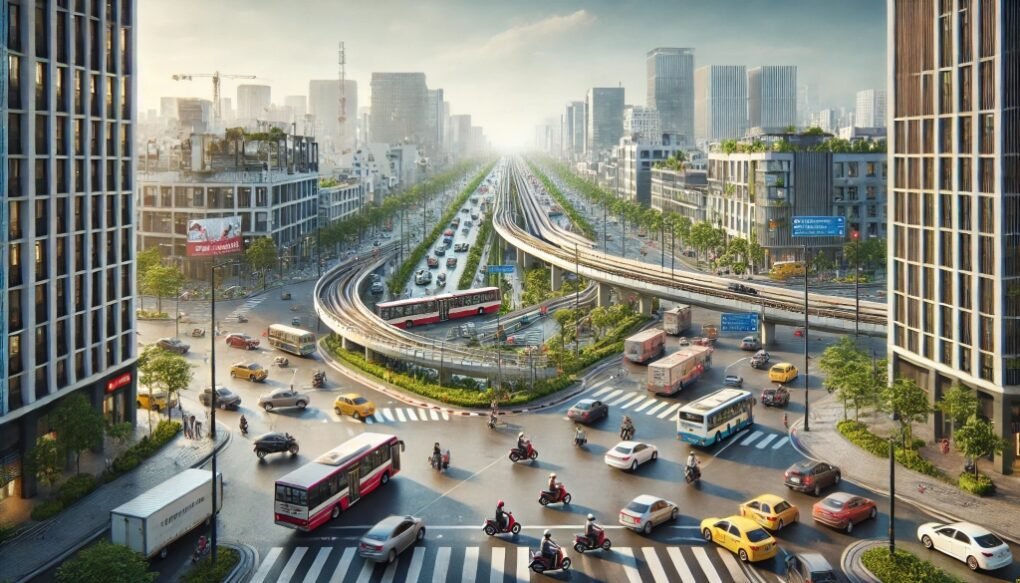Ngã Tư An Sương is one of the most significant intersections in Ho Chi Minh City, Vietnam. Located in District 12, this busy crossroads connects important routes and is vital for the daily commute of thousands of people. Over the years, it has become an essential hub for transport, commerce, and urban development. In this article, we’ll dive deep into everything you need to know about Ngã Tư An Sương, its importance, traffic challenges, ongoing infrastructure projects, and its impact on the city’s economic landscape.
The History and Significance of Ngã Tư An Sương
Ngã Tư An Sương has a rich history, dating back several decades when it first started to gain attention as a crucial point in the city’s transport network. This intersection connects National Highway 1A and Trường Chinh Street, making it a strategic link between central Ho Chi Minh City and its neighboring provinces. As the city expanded, Ngã Tư An Sương became increasingly important, facilitating both local and long-distance transportation.
The area surrounding the intersection has transformed dramatically over the years. Originally a less developed suburban area, Ngã Tư An Sương is now surrounded by residential, commercial, and industrial zones. This rapid growth has amplified its significance, as it has become a hub for goods transportation and daily commuting. Today, Ngã Tư An Sương is not just an intersection; it’s a symbol of urban connectivity and development in Ho Chi Minh City.
Traffic Challenges at Ngã Tư An Sương
As one of the busiest intersections in the city, traffic congestion at Ngã Tư An Sương is a common issue, especially during peak hours. The high volume of vehicles, including motorbikes, cars, buses, and trucks, converging from various directions often leads to gridlocks. Several factors contribute to the persistent traffic problems:
- High vehicle density: Thousands of vehicles pass through the intersection daily.
- Lack of alternative routes: There are limited alternate roads for commuters, forcing many to use the same routes through Ngã Tư An Sương.
- Pedestrian and vehicle conflicts: With many people crossing on foot, pedestrian safety becomes a concern, adding to traffic delays.
- Heavy truck movement: Due to its location on National Highway 1A, many large trucks and transport vehicles use this intersection, further congesting the area.
Local authorities have recognized these issues and have implemented several initiatives to alleviate the problem. However, traffic jams remain a regular feature at this key intersection.
Ongoing Infrastructure Projects
To improve traffic flow and address congestion, several infrastructure projects have been initiated around Ngã Tư An Sương. The most notable improvement is the construction of overpasses and underpasses. These aim to streamline traffic by separating vehicle streams. These upgrades ensure smoother movement through the intersection. They especially help long-distance trucks, which previously caused significant congestion.
In addition to these large-scale projects, efforts have been made to widen roads, enhance traffic signals, and improve pedestrian crossings. These changes are part of a broader strategy to reduce congestion, improve safety, and ensure that Ngã Tư An Sương can handle increasing traffic as the city grows.
One key development is the construction of the An Sương Overpass, which was completed in phases to minimize disruption. This overpass is expected to significantly reduce congestion by creating a direct route for vehicles traveling on the National Highway.
The Role of Public Transport
Public transportation plays a critical role in mitigating traffic at Ngã Tư An Sương. The area is serviced by several bus routes, which connect different parts of the city and outlying provinces. The use of buses helps reduce the number of private vehicles on the road, providing an eco-friendly alternative for commuters.
Authorities have been working on improving public transport infrastructure around Ngã Tư An Sương, with the aim of making bus travel more convenient and reliable. This includes building dedicated bus lanes and enhancing bus stop facilities to encourage more people to use public transport.
Impact of Ngã Tư An Sương
The intersection of Ngã Tư An Sương is not just a traffic hub; it has a significant economic and commercial impact on the surrounding area. The convergence of important roads makes it a prime location for businesses, particularly those involved in logistics, transportation, and retail. The proximity to industrial zones has also led to the development of warehouses and logistics centers in the area.
Furthermore, the development of residential areas around it has boosted the local economy. Small businesses, such as restaurants, shops, and services, have flourished to cater to the growing population of commuters and residents. Real estate development has also surged in the vicinity, as the demand for housing near major transport routes has increased.
Future Prospects for Ngã Tư An Sương
The future of it looks promising, with several urban development projects underway. The expansion of the Metro Line 2, which is expected to pass through or near the intersection, will be a game-changer for public transportation in the area. This metro line will further ease congestion, providing an efficient alternative to road transport for thousands of commuters daily.
The local government will continue focusing on infrastructure improvements. Additional plans include widening roads and enhancing traffic management systems. Authorities also aim to create more pedestrian-friendly areas. As the city’s population grows, these developments will be crucial. They will help ensure that Ngã Tư An Sương stays functional and efficient in Ho Chi Minh City’s transport network.
Safety Concerns and Solutions
With its high traffic volume, safety at Ngã Tư An Sương has become a concern, particularly for pedestrians and motorbike users. Traffic accidents are not uncommon, often due to the mix of vehicles converging in a confined space. To address these safety concerns, authorities have taken steps such as:
- Installing better traffic lights and pedestrian signals to manage vehicle and foot traffic more effectively.
- Introducing stricter traffic rules for large trucks during peak hours.
- Enhancing road signage and marking pedestrian crossings more clearly.
These efforts are intended to reduce the risk of accidents and improve overall safety at the intersection.
It is a critical intersection that plays a vital role in the transportation network of Ho Chi Minh City. Its significance has grown over the years, thanks to rapid urbanization and its strategic location. While traffic congestion and safety remain ongoing challenges, the efforts of local authorities. It improve infrastructure and public transport are gradually making a difference. As the city continues to develop, it will likely remain a key focal point for both economic activity and transportation, shaping the future of urban life in the region.











